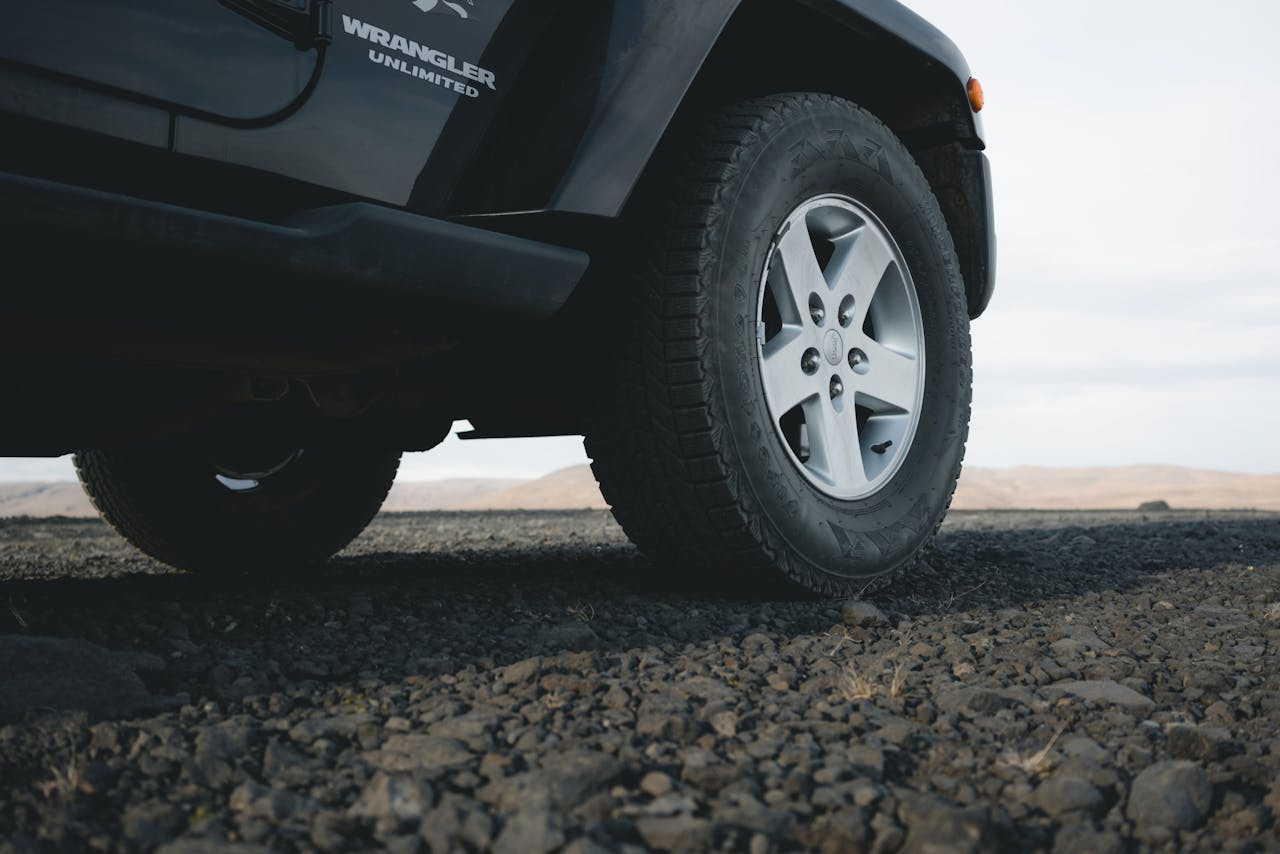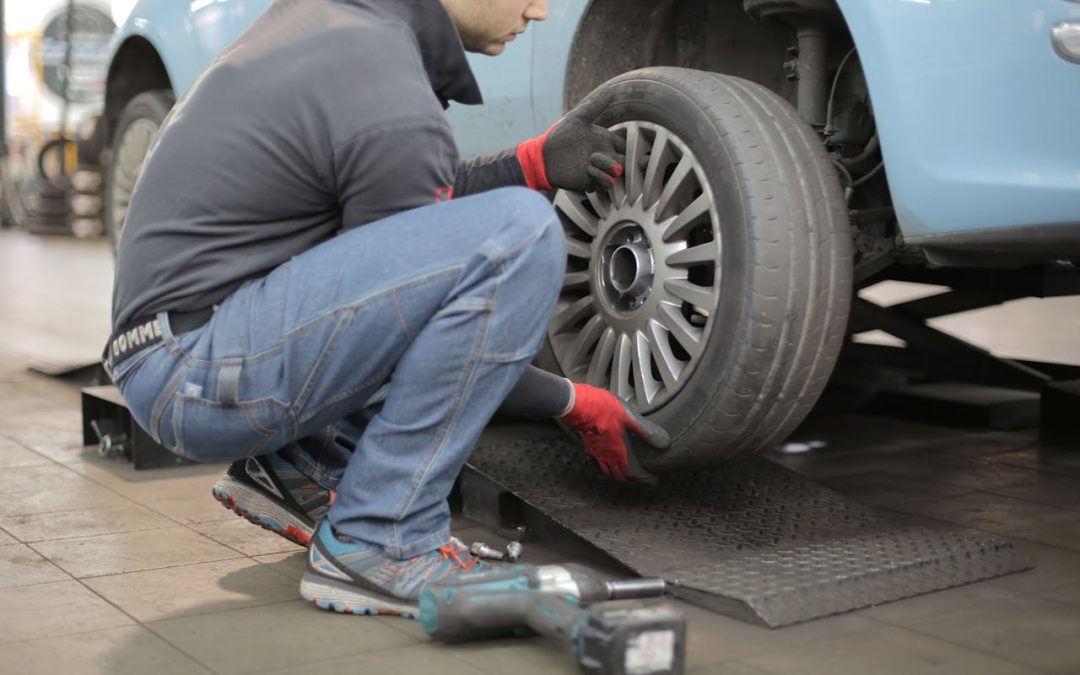Key Takeaways
- Tire balancing ensures even weight distribution across all tires, which is essential for a smooth ride, extended tire life, and optimal vehicle performance. Keeping them balanced can save you money by avoiding more expensive problems later.
- By failing to stay on top of car tire balancing, you risk uneven tire wear, more expensive fuel consumption, and even jeopardizing your vehicle’s safety. It will contribute to short life tires, premature damage to suspension components, and increased repair bills in the long run.
- Common culprits of tire imbalance are hitting a pothole, uneven wear on tires, and incorrect installation. With routine commercial vehicle inspections, problems can be identified and fixed before the issues become a hazard on the highway.
- Symptoms of imbalanced tires include steering wheel vibrations, irregular tread wear, and strange noises while driving. When these symptoms arise, having them fixed quickly can save you from worse damage down the line.
- The benefits of regular tire balancing include Greater fuel efficiency, increased safety A smoother, more comfortable ride. More importantly, it cuts wear and tear on vehicle components, saving significant dollars in maintenance.
- Pairing tire balancing with regular wheel alignment will set vehicles up for maximum performance, stability, and executed handling. Electing regular maintenance and nipping problems in the bud are important steps toward avoiding the price tag of neglect.
Uneven wear is only the beginning of the dangers associated with neglecting this important service. Out-of-balance tires can create harsh, uncomfortable vibrations that damage sensitive suspension parts prematurely. In the long run, this can lead to expensive repairs and decreased fuel economy, making you spend more on gas.
Uneven tire wear creates unnecessary additional expense by prematurely wearing out your tires, so that you have to replace them more often. Apart from the cost and inconvenience, the handling can be affected, causing the vehicle to feel shaky, particularly at highway speeds, and increasing the risk of an accident.
Regular tire balancing means a smoother ride, more safety, and fewer unexpected costs. Let’s look into the big cost of neglecting tire balancing and how this basic upkeep tactic can spare you headaches and cash down the road.
Why Do Tires Become Unbalanced?
Tire imbalance is one of the most underdiagnosed issues and usually isn’t detected until it has begun to negatively impact the vehicle’s performance. Learning how and why tires become unbalanced is key to keeping them in good shape and providing a smooth, safer ride. Many issues are at play, from the way you drive to where you live.
Common Causes Of Imbalance
Potholes, curbs, and other debris can cause your tires to go out of balance instantly. These forces can move tire weights or even warp the wheel, creating an unbalanced rotation.
A second culprit is uneven tire wear. Tire tread wears down unevenly. This can be a sign that your wheels are misaligned. Such an imbalance wreaks havoc on handling and increases tire wear considerably.
Extreme temperature shifts can affect tire pressure. Temperature changes and fluctuations create an expansion and contraction of the air within, which can easily change the balance and handling characteristics of tires.
Road Hazards And Impacts
Road hazards such as bumpy surfaces, gravel, or obstacles can further contribute to tire imbalance. Activities you may not even consider can wear a tire down unevenly, such as driving regularly on loose gravel or dirt roads.
Even small accumulative damage to the tires or rims exaggerates these problems, compromising ride quality and safety. Being vigilant in maintaining road conditions and potentially avoiding hazards altogether are the best ways to prevent imbalance.
Wear And Tear Over Time
Additionally, natural degradation of tires is bound to occur over time. Extended use without proper maintenance, like rotating your tires every 3,000 to 5,000 miles, can make the issue even worse.
What Tire-Related Factors Lead To Imbalance? Older tires are also most likely to be impacted by imbalance, as their structure weakens with age.

Signs Of Imbalanced Tires
The impacts of these symptoms, which are all signs of imbalanced tires, can take a toll on your ride and vehicle. By keeping an eye out for these signs, you can identify imbalanced tires before they cause serious damage, saving yourself money and keeping you safe.
Steering Wheel Vibration
An obvious indicator of tire imbalance is a sensation of vibrations or shaking in the steering wheel. These vibrations usually only intensify at higher speeds, leaving highway driving especially unpleasant. Avoiding it only leads to major issues down the line.
You could risk premature wear on suspension parts and compromised control of your steering wheel. Don’t take vibrations for granted because doing so puts your safety and comfort at risk. More importantly, they compromise your vehicle’s handling, especially in evasive maneuvers and other emergency scenarios.
Research shows 85% of imbalanced tires cause the kind of vibrations drivers would easily detect. This means it’s especially important to find a solution without delay.
Uneven Tire Wear Patterns
When tires are imbalanced, they will wear unevenly, meaning that the tread will wear down quicker in some places than others. This abnormal tread wear makes your tire wear out a lot faster, leaving you with a higher replacement cost.
As studies show, 60% of uneven tire wear is caused by imbalance, making it a critical factor in long-term tire performance. Regularly inspecting tire tread for irregular patterns can help identify imbalance early, extending the life of your tires while improving safety.
Ride Discomfort And Noise
When tires are unbalanced, they can cause bumpier rides, which leads to a more unpleasant driving experience. You may start to hear strange noises like humming or thumping while you drive. Usually, these sounds indicate that balance problems are brewing.
A comfy, peaceful ride makes all the difference in your driving experience. By fixing these problems, you can bring back recline and make every ride more pleasant.
The Real Cost Of Neglecting Tire Balancing
Tire balancing may seem like a simple maintenance task. Neglecting tire balancing affects you more than you realize. It not only contributes to tire wear and failure. Applying any less effort toward it results in a chain of unnecessary costs and tradeoffs that compound over time.
Accelerated Tire Wear And Reduced Lifespan
When you skip out on tire balancing, your tires end up with an uneven weight distribution that results in irregular wear patterns. This reduces the lifetime of your tires, so you’ll have to buy them more often.
With properly balanced tires lasting upwards of 40,000–60,000 miles, that disregard can mean the difference between long-term use and quick replacement. Tire replacement due to the avoidance of balancing is expensive.
Oddly enough, replacing one tire at $100–$300 each adds up quickly. The cost of replacing four tires is $400–$1,200.
Increased Fuel Consumption
If your tires are unbalanced, you’re increasing the amount of rolling resistance on your vehicle, making your engine work much harder. This wasted energy not only robs you of lost performance, but it also makes you use more fuel and spend more money at the pump!
With balanced tires, rolling is smoother, which means better mileage and more money in your pocket down the road.
Compromised Vehicle Safety
When tires are unbalanced, they can affect the balance of your vehicle, creating instability, control loss, and higher accident risk, particularly at higher speeds. Accident-related repairs average between $1,000 to $5,000, easily eclipsing the expense of consistent balancing.
Suspension System Damage
Improper or uneven tire rotation puts stress on the suspension system, causing it to wear out much quicker. Eventually, this results in expensive damages, where every penny spent now is worth dollars later, increasing the economic load.
Higher Repair Bills Down The Road
When tire balance is neglected, you run the risk of misalignment, suspension damage, and mechanical failure. Getting your tires regularly balanced will go a long way to minimizing these dangers.

Frequency Of Tire Balancing
Tire balancing is not just another routine maintenance procedure. It makes a big difference not only in optimal vehicle performance, but your safety on the road. Making sure to get your tires balanced regularly will save you from frequent uneven tires, improve fuel efficiency, and give you a smoother ride.
Though many variables change the frequency at which balancing is needed, following a regular schedule can have a huge impact.
Recommended Intervals
Routine balancing checks done every 3,000 to 6,000 miles will keep your ride smooth and prevent premature wear from excessive vibrations. New tire installation or tire rotation are times when balancing should be done on the spot.
If you drive a lot or on bumpy roads, you may want to get balanced every 12 months or sooner. Many manufacturers would recommend balancing every 12,000 to 15,000 miles.
So, regular checks can prevent small issues from becoming major problems to save you from expensive repairs in the future. For example, spending $50 to $75 per wheel to balance is more cost-effective than replacing tires that wear out too soon.
Factors Affecting Balancing Needs
For one, driving habits can make a huge difference. Aggressive acceleration or sudden braking increases imbalance. Likewise, a lot of driving on rough terrain or in pothole-heavy towns can hasten the development of uneven tire wear.
Vehicle type and weight make a huge difference as well. Larger vehicles or those that routinely transport heavier loads require more regular balancing to keep them balanced.
When To Seek Immediate Balancing
Noticeable vibrations in the steering wheel or floorboards often signal imbalance. A sudden deterioration in ride quality or irregular tread wear is are good reason for immediate action.
Addressing these signs promptly ensures safety and prevents further damage.
Tire Balancing VS. Tire Alignment
Tire balancing and tire alignment are commonly confused with one another, but they play very different roles in keeping your vehicle running smoothly. Tire balancing maintains an even weight distribution on each tire and wheel. This process helps to eliminate vibrations and helps to avoid uneven tread wear.
On the other hand, tire alignment realigns your wheels’ angles with your car’s frame. This adjustment helps the wheels to maintain even contact with the ground. While both services are essential to your vehicle’s optimal performance, they are two completely different services that solve two different problems.
Neglecting either one can cause premature tire wear, lower fuel efficiency, and even damage suspension parts.
Understanding The Differences
To get balance, you add little weights to the wheel. This step prevents any irregular distribution of weight and helps keep the rotation smooth at faster speeds. This avoids serious problems, such as a shaking steering wheel or passenger seat.
Alignment aims to control camber, caster, and toe angles so that tires touch the road in a straight line. Symptoms of misalignment include uneven tread wear, pulling to one side, or a crooked steering wheel.
While tire balancing helps to prevent vibration, tire alignment helps to maintain proper handling and stability. Neglecting either service can shorten tire life by thousands of miles and put safety at risk.
When To Perform Each Service
- After installing new tires, rotating them, or every 5,000–6,000 miles.
- No less than every 2 years, or when symptoms such as uneven wear, pulling, or squealing tires are noticed.
Synergistic Effects Of Both
When performed regularly, balancing and alignment work hand-in-hand to provide better handling, longer tire life, and a safer ride. Just a bad alignment can result in a 10% decrease in fuel efficiency, while balancing provides a smoother ride and more control.
Minimizing The Costs Of Tire Neglect
Ignoring tire maintenance or repairs will hurt vehicle performance, as well as incur the greater expense of tire neglect over time. By prioritizing proactive tire maintenance, you’ll save money and prolong the lifespan of your tires. We all know it, but small, consistent steps truly make a difference.
Schedule Regular Inspections
Performing inspections regularly is crucial to catching dangerous problems before they become serious. Looking for signs of uneven wear or balance issues, address small repairs before they turn into larger issues.
For example, detecting alignment issues during a $50 inspection can prevent uneven wear that might lead to replacing a $200 tire prematurely. Regular rotations ensure even wear, going a long way toward helping your tires last their expected lifespan of 25,000 to 37,000 miles.
Address Issues Promptly
Warning signs often manifest as vibrations or uneven tread, and ignoring these issues can result in major and expensive damage. For example, an out-of-balance tire can cause wear on suspension parts, causing its owners to spend an average of $465 per visit on repair.
Taking care of an imbalance right away protects your vehicle and prevents added costs from spiraling.
Choose Quality Tires
Choosing more durable, high-quality tires minimizes the risk of balance problems occurring and improves truck safety overall. With a good tire running around $150 to $300, that is adding up fast.
It performs and lasts much longer than lower-cost alternatives, saving you money in the long run.
Maintain Proper Tire Inflation
Tires that are under-inflated or over-inflated wear out unevenly and hurt fuel efficiency. Keeping them properly inflated to the manufacturer’s recommended PSI could increase gas mileage by as much as 3%.
A basic $2 tire gauge and a couple of minutes each month can go a long way to realizing the full performance of tires while saving money.
Debunking Tire Balancing Myths
Common misconceptions about tire balancing make it easy for drivers to overlook its importance. These myths can perpetuate a cycle, leading to a lack of proper maintenance and unforeseen costs later on. By putting these myths to rest, we can more effectively promote how balancing plays an essential role in a vehicle’s performance, safety, and cost-efficiency.
Common Misconceptions
Myth #1: Tire balancing is not needed until a vibration or similar issue occurs. In truth, imbalances can manifest without any audible or detectable cues, slowly destroying tires and expensive suspension parts.
An additional myth is that balancing is important only for high-end, performance vehicles. Most modern cars, even those using basic unleaded gasoline with an octane rating of 87, benefit from regular balancing as part of maintenance routines.
More advanced techniques, such as road force balancing, can work wonders in fixing ongoing vibration problems, even on the most touchy-feely vehicles like the Lotus. For the majority of daily drivers, traditional static balancing is more than sufficient.
Balancing As Preventive Maintenance
Tire balancing is a form of insurance against later headaches and expenses. This uneven wear can severely cut the life of a $160 tire set by over half.
This immediately puts the total cost of balancing the tires – an average of $80 – into perspective. Imbalances don’t just stop at tires; cracks can put unnecessary pressure on components such as the suspension and increase overall repair expenses.
By adding balancing to normal maintenance, drivers can prevent damaging cascading issues like this, which makes it an easy, convenient, and economical solution.
The Value Proposition Of Balancing
Balancing saves tires, saves fuel, and saves consumers from a bumpy ride. Finally, our shop foreman, Lindsey, showed that even bent wheels can often be repaired cost-effectively, saving wasteful spending.
Spending on the right balancing protects your vehicle’s longevity and safety, making it a proven value over the long haul.
Conclusion
Failing to balance your car tires gets expensive in more ways than one. Tires in poor shape compound the wear and tear on your vehicle. Beyond creating hazards to your ride’s smoothness and safety, they strain your fuel expenses. Keeping your tires balanced isn’t just about saving money—it’s about better handling, longer tire life, and fewer trips to the shop. Simple maintenance checks and balances go a long way, often saving you costly repairs down the road.
Whether you’ve observed abnormal wear, vibrations in the steering wheel, or your vehicle is pulling to one side, don’t neglect these signs. A short trip to your favorite mechanic today will keep more expensive disasters in the future at bay. Don’t wait until you’ve incurred the cost of ignoring proper car maintenance. Take the proactive approach, and your car will thank you with a smoother, more efficient ride.
Frequently Asked Questions
1. What Is Tire Balancing?
Proper tire balancing is a key factor in ensuring the weight of your tires and wheels is evenly distributed around their circumference. This stops vibrations as you drive and helps your tires wear evenly.
2. Why Do Tires Become Unbalanced?
Tires can lose their balance from everyday wear and tear, from uneven tread wear, or from things such as striking potholes or losing wheel weights. As time goes on, this imbalance can be cyclical, getting worse with a lack of maintenance.
3. What Are The Signs Of Imbalanced Tires?
Common symptoms are vibration in the steering wheel, abnormal tire wear patterns, decreased fuel economy, or driving noise. Neglecting these warning signs may result in damage to your vehicle, resulting in expensive repairs.
4. What Happens If I Don’t Balance My Tires?
Uneven tire wear, decreased fuel efficiency, a bumpier ride, and suspension component damage are just a few of the consequences. This contributes to an expensive cycle of increased repair and replacement costs.
5. How Often Should I Balance My Tires?
Most automotive experts will tell you to balance your tires every 5,000 to 6,000 miles, coinciding with tire rotation intervals. Regular checks ensure optimal performance and safety.
6. Is Tire Balancing The Same As Tire Alignment?
Tire balancing is all about balancing the weight around your wheels. Tire alignment is responsible for making sure your wheels are aligned at the proper angle to keep you rolling straight. Both are equally important to maintaining the health of your tires.
7. How Can I Save Money On Tire Maintenance?
Schedule regular tire balancing, avoid potholes, and rotate your tires as recommended. These easy maintenance practices will extend the life of your tires and save you money on car repair expenses.
Rev Up Your Ride With Expert Car Tire Balancing!
Experience the excellence of autoTECH Blackhawk in the realm of car tire balancing. Why choose us for your vehicle’s car tire balancing needs? Our standout feature is our unwavering dedication to building strong relationships with our clients, a crucial element in the specialized field of car tire balancing. This commitment forms the cornerstone of our tailored services, ensuring our solutions align with your specific goals for safety, efficiency, and long-term tire health.
Whether you’re dealing with vibrations, uneven tread wear, steering wheel shimmy, or simply seeking expert advice on how to maintain your tires’ integrity, autoTECH Blackhawk is here to exceed your expectations. We take immense pride in our industry-leading 3-year/36,000-mile warranty and our commitment to using only high-quality, manufacturer-recommended parts and components.
Don’t hesitate to contact our friendly team today to schedule a convenient and contactless consultation for your car tire balancing needs!


